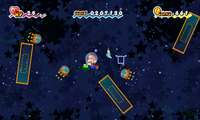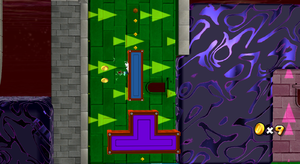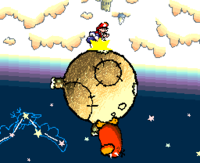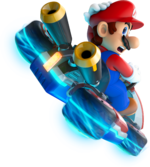Gravity
Gravity in the Super Mario franchise is a theoretical force that draws two or more objects together. While gravity points in a consistent direction in most Super Mario media, some games have mechanics that revolve around altered and planetary gravity. Gravity itself informs other game mechanics, such as the presence of pits as an obstacle. In 3D platforming games, shadows are usually cast along the direction of gravity, to help show how objects are aligned in space.
The Moon's gravitational pull being weaker than Earth's own is often referenced in the Super Mario franchise, by having locations on the Moon use lighter gravity or otherwise using gravity altering mechanics. It is also linked to cosmic-ness in general.
History[edit]
Super Mario World 2: Yoshi's Island[edit]
Altered gravity in Super Mario World 2: Yoshi's Island is featured only in the boss fight of Raphael The Raven's Castle, where Yoshi must run around the moon and Ground Pound the Stumps to attack Raphael the Raven on the other side. Yoshi is always shown upright; the arena rotates under him.
Yoshi Topsy-Turvy[edit]
Gravity in Yoshi Topsy-Turvy is a key gameplay mechanic. The player can manipulate gravity and tilt the world accordingly by tilting Game Boy Advance left or right, resulting in items, enemies tilting in the same direction, or sometimes even obstacles such as boulders.
Super Mario series[edit]
Super Mario Galaxy / Super Mario Galaxy 2[edit]
Gravity in Super Mario Galaxy and Super Mario Galaxy 2 can have its direction expressed by the shape and appearance of a planetoid, but is actually controlled by invisible game objects that direct gravity toward the surface of basic shapes:[1][2]
GlobalPlaneGravity: Gravity vectors point in a consistent parallel direction, toward a plane. This can work like gravity in other games, or point in other directions like upside down or sideways. There is a variant with a finite hitbox,GlobalPlaneGravityInBox. In 2D sections, areas with different planar gravities may be indicated with gravity fields.- Sphere: Gravity vectors point toward a sphere, as is typical of a planet. The Gateway Galaxy's planets all exhibit this gravity field, and another example is the small asteroid visited in the Good Egg Galaxy's third mission, King Kaliente's Battle Fleet, as well as the Question Mark Planet's moon in the Gusty Garden Galaxy.
GlobalCubeGravity: Gravity vectors point parallel to the faces of a cube, with abrupt transitions along the diagonals from the edges. An example is the Gusty Garden Galaxy's Puzzle Cube.GlobalWireGravity: Gravity vectors point toward a line-based path. The line can be straight (as with the Pill Planet in the Good Egg Galaxy or curved (as with the Question Mark planet in the Gusty Garden Galaxy).GlobalConeGravity: Gravity vectors point toward the curved surface of a conical frustum. Examples include the Ocean Pudding Planet in Sea Slide Galaxy, the giant ice cream cone planet in Toy Time Galaxy, and the Starting Planet of the Dreadnought Galaxy (only in Infiltrating the Dreadnought; in Revenge of the Topman Tribe, it has Global Disk Gravity, and its top part is squashed to accommodate.)GlobalDiskTorusGravity: Gravity vectors point toward the edge of an open disk, creating a torus (doughnut)-shaped field. The Hedge Ring Planet in the Gusty Garden Galaxy and the Starting Planet of the Freezeflame Galaxy exemplify this.GlobalDiskGravity: Gravity vectors point toward the surface of a closed disk, rounded between faces in the space around the edge. The Battlerock Galaxy's Starting Planet (and, by extension, that planet's copies) and the main part of the Starting Planet of the Good Egg Galaxy have this gravity field, and in the Dreadnought Galaxy, the Starting Planet gets this gravity field in Revenge of the Topman Tribe.- Wedge: Gravity vectors point toward a concave shape, that of the curved ramps in the Good Egg Galaxy starting planet's secret room. Another example on the same planet is the curved part of the walkway up the tower.
GlobalBarrelGravity: Only found in Super Mario Galaxy 2. The gravity vector field curves around the center axis of a cylinder. Two examples are the Wood Drum Planet and Wood Circle Cut Planet in Tall Trunk Galaxy, each with relatively perpendicular 2D sections to each other; the former snaps Mario to a cylindrical shell, and the latter to a circular cross-section.
In practice, this leads to four main conceptual models of gravity:
- Planetary gravity, which draws Mario in on all sides of the planet. This allows Mario to traverse the underside of a planet. An example of this is the mini-planets in the Gusty Garden Galaxy.
- Absolute gravity, which pulls Mario down, regardless of the planet's center. Mario is expected to slide down slopes, rather than rotating to stand on them. Falling off of the planet acts as a bottomless pit, causing Mario to lose a life even if he is not pulled into a black hole. An example is Honeyhive Galaxy's starting planet.
- Outward gravity, which pulls Mario to the sides of a planet when he is inside one. Examples include the Tower Planet in Bowser's Galaxy Reactor, and the Warp Pipe area on the inside of the Asteroid Planet in Good Egg Galaxy.
- Toroidal gravity, also referred to as[citation needed] "orbital" or "fall forever" gravity, which pulls Mario around the curved surface of a cylindrical planetoid. Another example is the Abandoned Rocketship Planet in Space Storm Galaxy. The first cylindrical planet visited in the Sky Station Galaxy's second mission, Storming the Sky Fleet, has this type of gravity field inside.
Gravity is also manipulated in several levels, using gravity switches, which change the direction of gravity of the surrounding area; gravity spotlights, which push Mario toward a surface or another place like a tractor beam; and the grates and dirt patches in Flipsville Galaxy, which flip Mario's gravity when crossed. Pull Stars, Sling Stars, and Launch Stars allow Mario to ignore gravity while they are used.
Black holes use gravity to draw Mario or Luigi into them if they get too close, causing them to lose a life.
While shadows are still usually cast along the direction of gravity, there are exceptions when other spatial information is more important. For example, coins cast their shadows toward honey walls to show their position in space, even though it is not because of gravity that Bee Mario sticks to these walls. These exceptions are handled with invisible game objects similar to the ones that control gravity.
Super Mario Odyssey[edit]
Gravity in Super Mario Odyssey can be altered in certain 2D sections accessed by 8-bit pipes. Mario can walk across any curved surface, with gravity changing to match. Some areas have gravity fields that determine gravity. Others, such as ones seen in the Moon Kingdom, have Mario hopping to circular 2D planets with different gravity.
Locations on the Moon, those being the Moon Kingdom, Dark Side, and Darker Side, have lighter gravity. While there, Mario jumps higher and falls slower. This does not apply to the rebounding off walls following a roll, long jump, dive, or quick swim, all of which result in fairly constant rate rises and falls. This effect extends to 2D sections, but does not affect underground areas such as the Underground Moon Caverns. It also does not affect underground 2D sections. The interiors of the Wedding Hall and the Odyssey are excluded, but this does not indicate buildings are exempt because the interior of Rabbit Ridge Tower is included.
Super Paper Mario[edit]

Gravity in Chapter 4 of Super Paper Mario is different than in other appearances, due to taking place in Outer Space. In Chapters 4-1 and 4-3, there is no gravity, allowing the player to navigate freely. Pressing any direction on the Wii Remote's D-Pad ![]() will automatically propel them in the given direction. When flipped into 3D, the player can only move laterally due to the lack of other controls for vertical movement. They cannot stomp enemies in zero gravity and must instead use Squirps' Squirt Beam.
will automatically propel them in the given direction. When flipped into 3D, the player can only move laterally due to the lack of other controls for vertical movement. They cannot stomp enemies in zero gravity and must instead use Squirps' Squirt Beam.
Chapter 4-2 takes place on Planet Blobule, which has low gravity, allowing the characters to jump much higher than normal and to fall much slower.
Chapter 4-4 takes place in the Whoa Zone, which has normal gravity. However, entering certain doors and pipes may place the characters on the walls or ceiling of a room. Later in the level, gravity switches are found, which change the direction of the player's personal gravity.
Mario & Luigi: Dream Team[edit]
- Main article: Luiginary Gravity
- Main article: Luiginary Antigravity
In Mario & Luigi: Dream Team, gravity in the Dream World can be affected by two Luiginary Works: Luiginary Gravity and Luiginary Antigravity. Luiginary Gravity changes gravity to point in any one of the four cardinal directions, and Luiginary Antigravity removes gravity so that Mario can swim through the air.
Mario Kart series[edit]
Mario Kart 7[edit]
In Mario Kart 7, one portion of Rainbow Road takes place on the Moon. This segment has lighter gravity, enabling higher jumps and slower falling. It is very similar to the effect of underwater driving in the game, except without water or the propellers that karts use.
Mario Kart 8 / Mario Kart 8 Deluxe[edit]
- Main article: Anti-gravity
Gravity in Mario Kart 8 and its Nintendo Switch version appears in the form of anti-gravity, which allows vehicles to drive on upside-down and vertical sections of courses, and to perform Spin Boosts. According to Mario Kart 8 producer Hideki Konno, this mechanic was inspired by the aforementioned portion of 3DS Rainbow Road in Mario Kart 7.[3]
Gallery[edit]
The Spirit Who Loves Surprises teaching Yoshi how to use Gravity in Yoshi Topsy-Turvy




